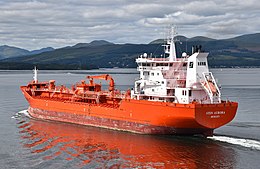


A chemical tanker is a type of tanker ship designed to transport chemicals in bulk. As defined in MARPOL Annex II, chemical tanker means a ship constructed or adapted for carrying in bulk any liquid product listed in chapter 17 of the International Bulk Chemical Code.[1] As well as industrial chemicals and clean petroleum products, such ships also often carry other types of sensitive cargo which require a high standard of tank cleaning, such as palm oil, vegetable oils, tallow, caustic soda, and methanol.
Oceangoing chemical tankers range from 5,000 tonnes deadweight (DWT) to 35,000 DWT in size, which is smaller than the average size of other tanker types due to the specialized nature of their cargo and the size restrictions of the port terminals where they call to load and discharge.
Chemical tankers normally have a series of separate cargo tanks which are either coated with specialized coatings such as phenolic epoxy or zinc paint, or made from stainless steel. The coating or cargo tank material determines what types of cargo a particular tank can carry: stainless steel tanks are required for aggressive acid cargoes such as sulfuric and phosphoric acid, while 'easier' cargoes — such as vegetable oil — can be carried in epoxy coated tanks. The coating or tank material also influences how quickly tanks can be cleaned. Typically, ships with stainless steel tanks can carry a wider range of cargoes and can clean more quickly between one cargo and another, which justifies the additional cost of their construction.
- ^ [MARPOL Annex II, Chapter I, Regulation 1]